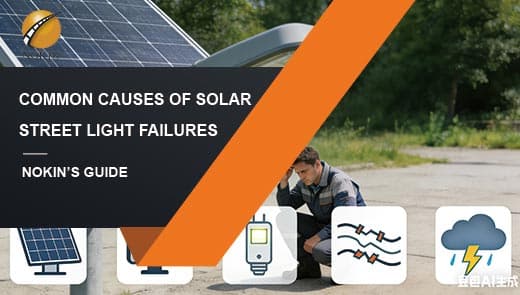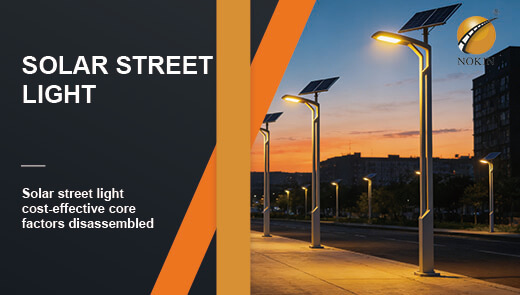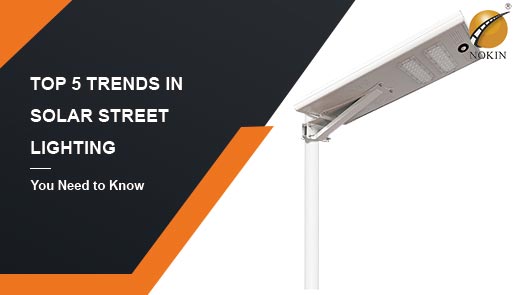Park Solar Street Lights: Benefits, Installation & Smart Solutions
Parks are important spaces for urban residents to relax and get close to nature, and nighttime lighting is key to ensuring this experience. Whether it's elderly people taking an evening stroll, young people jogging at night, or families camping on the weekend, they all need sufficient and reliable lighting.
However, traditional park lighting has long faced three major challenges: first, reliance on the power grid, with high costs for laying cables in remote areas and potential damage to vegetation and pathways; second, staggering energy consumption, with traditional light sources like high-pressure sodium lamps accumulating annual electricity costs that become a heavy burden on park operations; and third, cumbersome maintenance, with frequent issues like cable failures and light source degradation, which not only increase labor costs but may also lead to prolonged darkness in certain areas, posing safety risks.
The emergence of solar street lights, centered on the principles of “solar power supply, independent operation, and intelligent regulation,” addresses these challenges at their root. They not only illuminate park nights but also provide comprehensive solutions for ecological conservation, safety assurance, and cost control.
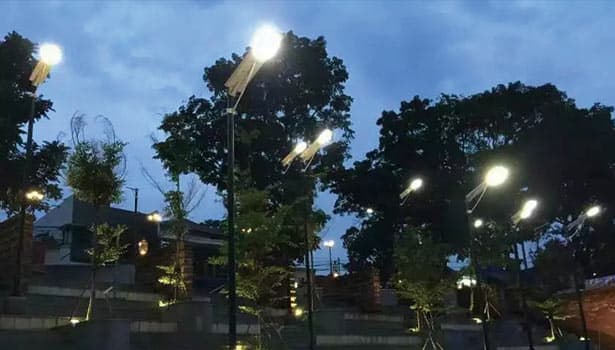
Limitations of Traditional Park Lighting
To understand the value of solar street lights, one must first recognize the limitations of traditional lighting in park settings.
Grid Dependency Hinders Lighting Implementation
Traditional streetlights must be connected to the municipal power grid, which poses a significant challenge for parks.
For newly constructed parks located in remote areas (such as suburban green spaces or wetlands), the distance required to connect to the grid could span several kilometers, with cable installation and transformer setup costs potentially exceeding 100,000 yuan. For existing parks seeking to add lighting (such as expanding pathways or adding resting areas), excavating roads to bury cables would directly damage lawns and stone paths, compromising landscape integrity.
Even more challenging are parks within nature reserves, where strict environmental regulations prohibit large-scale construction, making traditional streetlights nearly impossible to install, leaving these areas in a long-term “nighttime blind spot.”
High Hidden Costs of Traditional Lighting
The “hidden costs” of traditional park lighting far exceed the initial investment:
- High electricity costs: A single 400W high-pressure sodium lamp, operating for 10 hours daily, consumes approximately 146 kWh annually. At a commercial electricity rate of 1.2 yuan per kWh, the annual electricity cost per lamp is roughly 175 yuan; If the park has 50 lamps, the annual electricity cost reaches 8,750 yuan, totaling nearly 90,000 yuan over 10 years.
- Frequent replacements: High-pressure sodium lamps have a lifespan of only 1–2 years, and components like ballasts and wiring also wear out easily. The annual replacement cost for 50 lamps (including labor) averages approximately 5,000 yuan, which adds up to a significant expense over time.
Traditional Lighting Equipment is Difficult to Maintain
The wiring of traditional streetlights is buried underground, making them prone to short circuits during heavy rains or soil subsidence. Electrical components inside the lamp posts are also susceptible to moisture over time, leading to flickering lights.
Park maintenance staff often need to conduct frequent inspections. Once a fault is detected, they must excavate and repair it, which not only takes time (a single repair may require 1-2 days) but also temporarily closes off certain areas, affecting visitor access. Worse still, if the fault is not addressed promptly, dimly lit corners may become safety hazards, potentially causing visitors to trip and fall on pathways, leading to disputes.
Core Advantages of Solar Street Lights in Parks
Compared to traditional lighting, solar street lights offer comprehensive advantages for parks, from ecological conservation to visitor experience, and operational management, achieving significant upgrades across the board.
Solar Street Lights Protect Park Ecology
One of the core values of parks is promoting ecological concepts, and solar street lights themselves serve as a “green symbol.”
They convert sunlight into electricity via photovoltaic panels, with zero carbon emissions throughout the process. Data shows that a 30W solar LED streetlight generates approximately 120 kWh of electricity annually, compared to a traditional streetlight of the same brightness (approximately 150W), reducing carbon dioxide emissions by 120 kilograms—equivalent to planting six trees annually.
For parks that emphasize “ecological values” (such as wetland parks and botanical gardens), solar street lights require no ground disturbance and do not rely on fossil fuels, perfectly aligning with the principle of “minimal intervention in nature,” enabling lighting to harmoniously coexist with natural landscapes.
Solar Street Lights Enhance Nighttime Safety in Parks
Nighttime safety in parks begins with “visibility.” solar street lights are designed with multiple features to ensure light coverage in critical areas:
- Reliable lighting around the clock: Built-in smart controllers precisely detect changes in light levels, automatically turning on at dusk and off at dawn, avoiding issues like “turning off too early” or “turning on too late.” Even on cloudy days, high-quality batteries ensure stable lighting for 8–10 hours.
- Comprehensive coverage: By pre-planning the spacing between lamp posts (typically 15-20 meters) and combining this with the wide-angle illumination of LED light sources, dark corners are eliminated in areas such as walkways, lawns, and parking lots, reducing the risk of tripping or getting lost.
- Security integration: Some models are equipped with infrared sensors. Upon detecting abnormal activity (such as late-night intrusions), they automatically increase brightness and send an alarm, adding an extra layer of safety for visitors and facilities.
Solar Street Lights Reduce Maintenance Burdens
The “maintenance pressure” that park managers find most headache-inducing is significantly alleviated by solar street lights.
|
Comparison Item |
Traditional Street Lights |
Solar Street Lights |
|
Lifespan |
Light source: 1–2 years; wiring: 3–5 years |
Solar panels: 15–20 years; LED: 5–8 years |
|
Annual Maintenance Frequency |
3–5 times (wiring and light source inspections) |
1–2 times (solar panel cleaning) |
|
Electricity Costs |
150–200 yuan per lamp per year |
0 |
As shown in the table, the “zero electricity costs + low maintenance” characteristics of solar street lights can save parks a significant amount of operational costs. Taking a park with 50 lamps as an example, over 10 years, the cumulative savings in electricity costs and maintenance fees amount to approximately 150,000 yuan, far exceeding the initial investment difference.
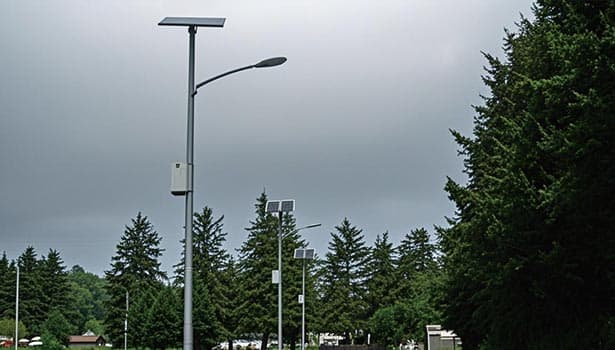
Key Features of Solar Street Lights in Parks
Solar street lights have established themselves in parks not only due to their concept but also because of their technically designed solutions tailored to the specific environment.
Independent Power Supply
Solar street lights form a complete “mini power supply system”—solar panels generate electricity, batteries store it, and controllers manage distribution, all without relying on the grid.
This feature makes installation extremely simple: simply pour a cement base (approximately 60 cm in diameter and 80 cm deep) at the selected location, secure the lamp post, and assemble the photovoltaic panels, lighting fixtures, and batteries. The entire process requires no road excavation or cable laying, and 1–2 workers can install 10 lights in a single day.
Whether in the center of a lawn, along a lakeside path, or on a gentle slope, installation is effortless, perfectly preserving the park's original landscape and vegetation.
Efficient Lighting
The core requirement for park lighting is “sufficient brightness without waste.” Solar street lights achieve this balance through advancements in lighting technology:
- LED lighting advantages: Luminous efficacy as high as 90-110 LM/W, far exceeding high-pressure sodium lamps. This means that to achieve the same lighting effect, the power consumption of solar LED lights is only 1/3 to 1/2 that of traditional street lights.
- High color rendering index: The color rendering index (CRI) of LEDs is >75, while that of high-pressure sodium lamps is only approximately 23. In simple terms, the former's light is closer to natural light, accurately reproducing the true colors of vegetation and road surfaces, thereby reducing nighttime visual errors (such as stepping into puddles or tripping over stones).
- Secondary optical design: Through special lens angle design, light can be precisely focused on areas requiring illumination, such as walkways and activity zones, avoiding “inefficient projection” into the sky or green spaces, thereby improving light energy utilization by over 30%.
Flexible Expansion
A park's functions may change over time—for example, adding a children's play area or expanding cycling paths. In such cases, the “modular design” of solar street lights demonstrates its advantages.
Its photovoltaic panels, batteries, and lighting fixtures can be replaced or upgraded individually. For example, if foot traffic increases in a certain area, larger-power LED lights can be replaced individually; if there are more consecutive days of rain, an additional photovoltaic panel can be installed to increase power generation.
This flexibility allows the lighting system to “adjust as needed,” avoiding the need for complete replacement due to functional upgrades, significantly extending the equipment's lifecycle.
Smart Features of Solar Street Lights in Park
Modern solar street lights are no longer just “lighting tools”; they also utilize smart technology to achieve “on-demand lighting,” further enhancing efficiency and safety.
Motion Sensors
During periods of low foot traffic (such as after 11 PM), the street lights can automatically reduce brightness to 30% to maintain basic lighting; When sensors detect pedestrians, bicycles, or pets approaching, they will increase to 100% brightness within 1-2 seconds, and return to low brightness 30 seconds after the pedestrian leaves.
This design reduces energy consumption by over 60%, making it particularly suitable for parks with fluctuating nighttime foot traffic (such as community parks that are quiet on weekdays and bustling on weekends).
Remote Control System
Managers can monitor the operational status of each light in real-time via a mobile app or computer backend:
- View remaining battery power, current brightness, and photovoltaic panel power generation efficiency;
- Adjust lighting schedules by season (e.g., delaying activation by 1 hour in summer when it stays light later);
- Remotely set special modes (e.g., extended lighting hours during holidays or automatic brightness enhancement during heavy rain).
This system transforms lighting management from “on-site inspections” to “remote control,” significantly reducing manpower requirements.
Lighting and Monitoring “Two-in-One”
Some solar street lights can integrate low-power cameras and WiFi modules to achieve dual functions of “lighting + monitoring”:
- Cameras in key areas (e.g., parking lots, children's play areas) can transmit real-time footage, with automatic alerts for abnormal situations (e.g., equipment damage, crowd gatherings);
- Cameras are powered by solar energy, eliminating the need for additional wiring and offering flexible installation;
- Combined with the LED lights' high-frequency flashing function, emergency situations can trigger warning signals to quickly attract the attention of management personnel.
Park Solar Street Lights Installation and Maintenance
The “peace of mind” offered by solar street lights is not only evident during operation but also throughout the entire installation and maintenance process.
Three Steps to Complete Solar Street Light Installation
- Step 1: Site Selection and Foundation. Determine the pole location based on lighting requirements (avoid tree obstructions to the photovoltaic panels), and pour a cement foundation (diameter 50–80 cm, depth 60–100 cm, ensuring wind resistance and stability).
- Step 2: Equipment assembly. Once the foundation has cured, secure the lamp post and install the photovoltaic panels (best at a 30° southward tilt), LED lighting fixtures, and batteries (batteries are typically built into the base of the lamp post and are waterproof and dustproof).
- Step 3: System commissioning. Connect the controller, set the lighting mode (e.g., light-controlled + time-controlled), adjust sensor sensitivity, and test for smooth brightness transitions.
The entire process is noise-free and dust-free, causing minimal disruption to visitor activities, and can even be carried out while the park remains open.
Solar Street Lights Require Low Maintenance Frequency
- Routine maintenance: Clean the solar panels quarterly (wipe dust and leaves with a soft cloth) to ensure optimal power generation efficiency; inspect the light pole for loosening and the fixtures for damage.
- Regular inspections: Conduct a comprehensive inspection annually, including battery capacity testing (replace aged batteries promptly), reinforcing electrical connections, and updating controller software.
- Troubleshooting: Modular design simplifies repairs — if a light fixture is not illuminating, simply replace the LED module; if power generation is insufficient, inspect the photovoltaic panels or connection cables without needing to dismantle the entire system.
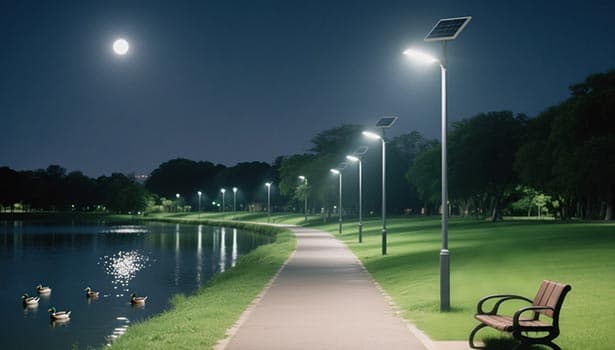
Summary
The value of solar street lights in parks goes far beyond “saving electricity costs” or “reducing maintenance.” It is a comprehensive solution integrating ecological protection, safety assurance, and intelligent management:
For visitors, it means a brighter and safer nighttime experience; for managers, it represents lower operational costs and more efficient management methods; for the city, it is a concrete implementation of “green infrastructure,” demonstrating a commitment to sustainable development.
From community parks to large suburban parks, solar street lights can be tailored to suit any setting—whether it's a community park emphasizing energy efficiency, a family-friendly park prioritizing security, or a nature park focused on ecology, it can become the most reliable “guardian” of the night.
Choosing solar street lights ensures that the park's nights are not only illuminated but also filled with warmth and intelligence.

